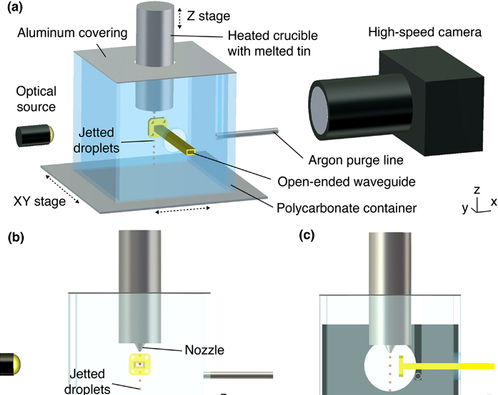工程师在劳伦斯·利弗莫尔国家实验室(LLNL) have developed a way of optimizing the properties of any parts produced via Liquid Metal Jet (LMJ) 3D printing.
LLNL团队没有采用昂贵的高速摄影方法,而是设计了一种将近场检测与仿真相结合的方法,在分析喷射材料时仅关注一个参数。研究人员说,利用他们的方法论,可以在调整打印机的设置以“保证零件质量”之前实时确定喷嘴问题的原因。
“Our results demonstrate that in-situ monitoring of LMJ is possible with millimeter-wave detection methods,” said the study’s lead author Tammy Chang. “This is exciting because it means we could replace computationally expensive high-speed, high-resolution optical diagnostics to enable real-time performance evaluation and feedback control, to ensure high-quality printed metal parts.”
Diagnosing LMJ issues in-situ
‘Liquid Metal Jetting’ describes a process whereby tiny metal droplets are fired at high speed from a nozzle, to form layers that can be built up into homogeneous parts, in a similar approach to that of inkjet printers. Compared to laser-based systems, however, LMJ machines don’t require the use of hazardous metal powders, thus they potentially offer a safer means of reaching the same ends.
随着该技术继续找到新的应用程序,其性能也受到了更大的审查,并且在某些应用程序中,确定最佳参数集已被证明很难。这很大程度上是由于以下事实:喷气材料可能会受到多种因素的影响,从液滴尺寸和喷射正时到速度,流速和温度。
尽管高速摄影通常用于分析LMJ的作用,但由于处理限制,该方法只能真正使用几秒钟,因此大量数据需要几天的时间才能筛选。为了使实时分析更合理,LLNL团队开发了一种可扩展的方法,该方法更依赖于模拟,而不是捕获千兆字节的信息。

可以使用工厂的LMJ监控?
工程师修订后的诊断方法涉及在生产过程中放置垂直于打印机的开放式波导,以便任何喷射液滴都通过其光圈的电磁场。通过这样做,可以以原位捕获金属液滴的动力学,这种方式需要收集的数据,而不是单独使用视频分析所需的数据要少得多。
To put their method into practise, the LLNL team inserted an aluminum waveguide into an LMJ 3D printer’s build chamber, and set up cameras at opposite sides of the system to capture the results. Interestingly, by focusing on one parameter at a time, the researchers were able to accumulate enough data to gain fascinating insights into the behavior of droplets via electromagnetic simulations.
During jetting, for instance, the team were able to non-invasively identify the precise impact that droplet spacing and diameter have on the properties of printed layers. Through further evaluation of their data, the engineers were also able to find the reason behind a clogged print nozzle that occurred in their experiment, as there was an ‘observable variation’ in the wavelengths captured when it happened.
As it turned out, a tension had built up on the nozzle’s surface which prevented the material from being fired, and caused the droplet to stick in place until the printer’s next pulse ejected it. If deployed within a factory environment, the researchers therefore believe their approach could be used to determine the quality of deposited drops in real-time, allowing manufacturers to minimize print failures.
“Getting a clean ejection of a single drop that falls straight down is key to achieving good print quality,” concluded study co-author Andy Pascall. “High-speed videography works well in a lab-scale environment where we are testing new print parameters, but will never work in production. This type of diagnostic will be very useful in a production environment.”
While the LLNL diagnostic tool is currently capable of detecting features down to a size of 400–500 m, the team say that the frequency of their set-up could be raised in future to enable the monitoring of 50–100 m droplets. Alternatively, using other signal processing methods, it may even be possible to turn it into a closed-loop system, in which data can be used to adjust printing parameters on the fly.

AM’s material jet methodologies
Like many advanced production processes, material jet 3D printing is the subject of constant R&D, in which engineers are attempting to hone its mass manufacturing capabilities. That being said, it would be a mistake to think that the technology hasn’t found end-use applications already, as several firms across the industry now market technologies which could justifiably be called ‘material jetting.’
Stratasys公司例如,继续让明显cant strides forward with itsPolyjet technology,选择启动桌面J35 Pro今年早些时候。该系统旨在使公司在办公室环境中工作的人可以访问该公司的物质喷射过程,据说该系统非常适合于既是消费者和电子产品以及学术应用的理想选择。
With Multi Jet Fusion (MJF),生命值has developed another well known-material jetting technology, which has been adopted by 3D printing providers around the world. What’s more, as the compatibility of its machines have broadened, so have their applications, and the likes ofMaterialise以前有launched dedicated materialsthat are designed to unlock the potential of HP systems.
Elsewhere, material jetting specialistXJET已经找到了陶瓷兼容的最终用途牙科应用Carmel 14003D打印机,通过与Straumann合作. The system’s high-throughput and soluble support compatibility are said to be beneficial to the firm, in that its dental professionals are now able to spend more time with patients, as they don’t have to worry about post-processing printed parts.
The researchers’ findings are detailed in their paper titled “Millimeter-wave electromagnetic monitoring for liquid metal droplet-on-demand printing,” which was co-authored by T. Changa, S. Mukherjee, N. N. Watkins, E. Benavidez, A. M. Gilmore, A. J. Pascall and D. M. Stobbe.
要了解最新的3D印刷新闻,请不要忘记订阅3D Printing Industry newsletteror follow us on推特or liking our page onFacebook.
For a deeper dive into additive manufacturing, you can now subscribe to ourYouTube频道,包括讨论,汇报和3D打印进程的镜头。
Are you looking for a job in the additive manufacturing industry? Visit3D Printing Jobsfor a selection of roles in the industry.
特色图显示了LLNL团队的实验材料喷射诊断设置。图像通过应用物理学杂志。



